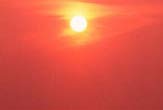Heat and Hype: The Truth about the Scorching Southwest

PHOENIX - The Southwest has been gripped by a deadly heat wave that might seem extraordinary to newcomers, those with short memories, or anyone who pays too much attention to the media.
"This has gone on a little too long," 41-year-old Arizona native Joe Della Rocca told the Associated Press.
Records seemed to melt across the region this week. A new high for the date was set Monday in Las Vegas: 116 degrees. In Phoenix, where eight deaths have been blamed on the heat, the mercury hit 116 Sunday, eclipsing the date's previous record of 114 set in 1936. Normal for this time of year is 107.
"This is the deadliest heat wave that I can remember," the assistant fire chief here said.
In Bullhead City, Arizona, the thermometer climbed to 124 on Sunday. The owner of the local Baskin Robbins claimed the heat melted a scoop of ice cream in eight seconds.
Death Valley topped out at 128 degrees Monday, a level not reached for many decades. A similar high was expected Tuesday.
You get the point. It's hot. But it is summer.
Sign up for the Live Science daily newsletter now
Get the world’s most fascinating discoveries delivered straight to your inbox.
"It is typical to have extreme temperatures this time of year," said Anton Haffer, the National Weather Service's chief meteorologist for Phoenix.
Haffer said in a telephone interview that in 15 years of forecasting here, he doesn't recall a summer when new record highs weren't set. There's a good reason why: Reliable records for U.S. weather data go back only to 1895. Many dots remain to be placed under the bell curve of this country's temperatures.
Another way to put the current heat wave into perspective:
"While many daily record temperatures have been set, there have been relatively few monthly or all-time records noted in the Southwest," said John Leslie, a public affairs officer for the National Oceanic and Atmospheric Administration (NOAA), which is the weather service's parent organization.
"While this region is unarguably in the midst of a significant heat wave, spells of very hot weather are not uncommon during the summer months," Leslie told LiveScience.
There are changes in the wind, however.
Haffer said that over the past few years, overnight lows in this sprawling metropolis have been climbing. This time of year, the coolest part of the early morning is sometimes still in the 90s.
The warmer mornings are due largely to the urban heat island effect, in which streets and buildings absorb more of the Sun's energy than would the natural landscape, and that heat is radiated back into the air all night long.
There are other recent data from around the country that might make you wonder if the weather isn't just a little weird.
The sweltering July comes after a very warm June. The average temperature across the contiguous United States last month was 0.9 degrees above the 1895-2004 mean, according to NOAA.
New York state, sticky-hot today, had its warmest June on record. In Wisconsin, Michigan and Vermont it was the second warmest June.
Again, however, these records are only for the past century or so.
It's been toasty around the world, too. In June, the average global temperature for combined land and ocean surfaces was 1.1 degrees above the 1880-2004 long-term mean, according to NOAA. It was the second warmest June since 1880.
Planet-wide, 2004 was fourth warmest year ever recorded. And global climate mechanisms already in place led scientists to predict back in February that this year will likely be the warmest ever.
Most climatologists agree that global warming is underway, and that over time it will become very problematic as vegetation changes and seas rise. But there is not enough data to tie global warming to individual events, most scientists say.
At any rate, this week's heat wave pales in comparison to historical hot times.
The all-time record high for Phoenix is 122, set on June 26, 1990. The all-time high nationwide is 134 degrees, set on July 10, 1913 in Death Valley.
Neither record will be challenged this week, forecasters say. Cooler weather is on the way. By Friday, Phoenix is expected to top out 3 degrees below normal, at a comparatively comfortable 104. But then watch out, warns Haffer. The monsoon season is likely to set in, bringing sticky humidity and potentially deadly thunderstorms.
- Is the Sky Really Blue?
- Billion Dollar Weather Disasters
- Urban Heat Makes Cities … Greener?
- El Nino Now Blamed for Practically Everything
- How Global Warming is Changing the Wild Kingdom
Deadly Heat
Historically, heat and drought have caused more damage and death in the United States than hurricanes or any other form of natural disaster. Heat waves in 1980 and 1988 each killed nearly 10,000 people.Learn More
Robert is an independent health and science journalist and writer based in Phoenix, Arizona. He is a former editor-in-chief of Live Science with over 20 years of experience as a reporter and editor. He has worked on websites such as Space.com and Tom's Guide, and is a contributor on Medium, covering how we age and how to optimize the mind and body through time. He has a journalism degree from Humboldt State University in California.










